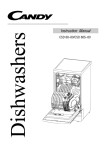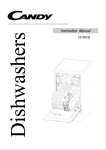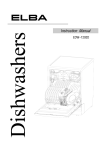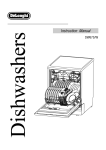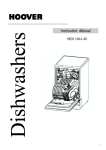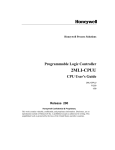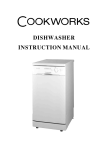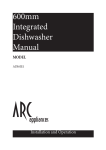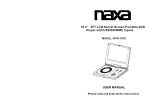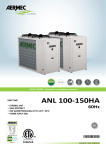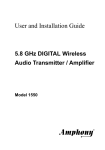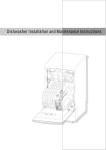Download Candy Dishwasher Operating instructions
Transcript
CDI454-S Downloaded from DishWasher-Manual.com Manuals ..................1 This manual contains sections of Safety Instructions,Operating Instructions, Installation Instructions and Troubleshooting Tips etc. Carefully reading it before using the dishwasher will help you to use and maintain the dishwasher properly. To review the section on Troubleshooting Tips will help you to solve some common problems by yourself and not need to ask for the help of professional technicians. Control Panel . . . . . . . . . . . . . . . . . . . . . . . . 2 Dishwasher Features . . . . . . . . . . . . . . . . . 2 Wash Cycle Table . . . . . . . . . . . . . . . . . . . . 3 Water Softener . . . . . . . . . . . . . . . . . . . . . . 4 Detergent . . . . . . . . . . . . . . . . . . . . . . . . . . . 5 Rinse Aid . . . . . . . . . . . . . . . . . . . . . . . . . 5, 6 Loading the Dishwasher Rack . . . . . . . . 6,7 Turning On the Appliance . . . . . . . . . . . . . . 7 Filtering System . . . . . . . . . . . . . . . . . . . . . 8 Caring for the Dishwasher . . . . . . . . . . . . . 9 About Electricity connection . . . . . . . . . . 9 About the Unicouple . . . . . . . . . . . . . . . . . 10 Water Connection . . . . . . . . . . . . . . . . . . . 10 Before calling for service. . . . . . . . . . 12 The manufacturer, following a policy of constant development and up-dating of the product, may make modifications without giving prior notice. Downloaded from DishWasher-Manual.com Manuals Under certain conditions, Hydrogen gas may be produced in a hot-water system that has not been used for two weeks or more. HYDROGEN GAS IS EXPLOSIVE. If the hot-water system has not been used for such a period, before using the dishwasher turn on all hot-water faucets and let the water flow from each for several minutes. This will release any accumulated hydrogen gas. As the gas is flammable, do not smoke or use an open flame during this time. This appliance complies with international safety standards, and is fitted with a plug with earth connection to ensure complete earthing of the product. Before connecting the appliance to the mains supply it is important to ensure: Ensure that your product is properly earthed. In the absence of adequate earthing you will notice that when touching the metal parts of your appliance an electrical dispersion can be felt, due to the presence of a radio interference suppressor. That the supply socket is properl y earthed. That your electricity supply is capable of meeting the consumption requirements listed on the rating plate of your appliance. This appliance complies with Directives 89/336/EEC, 73/23/EEC and following changes. Do not abuse, sit on, or stand on the door or dish Do not operate your dishwasher unless all enclosure panels are properly inplace. Open the door very carefully if the dishwasher is operating, there is a risk of water squirting out. rack of the dishwasher. Do not touch the heating element during or immediately after use. Do not place any heavy objects of stand on the door Do not wash plastic items unless they are marked when it is open. The appliance could tip forward. dishwasher safe or the equivalent. For plastic items not so marked, check the manufactures recommendations. When loading items to be washed: Use only detergent and rinse additives designed for an automatic dishwasher. Never use soap , laundry detergent, or hand washing detergent in your dishwasher. Keep these products out of children. Keep child away from detergent and rinse aid, keep When using your dishwasher, you should prevent plastic item from contacting with heating element. If the supply cord is damaged, it must be replaced child away from the open door of the dishwasher, there could still be some detergent left inside. by the manufacturer or its service agent or a similarly qualified person in order to avoid a hazard. The door should not be left in the open position since this could present a tripping hazards. Please dispose of packing materials properly. During installation, the power supply must not be excessively or dangerously bent or flattened. Use the dishwasher only for its intended function. Remove the door to the washing compartment when Do not tamper with controls. removing an old dishwasher from service or discarding it. The appliance is not intended for use by young children or infirm persons without supervision. Dishwasher detergents are strongly alkaline,they can be extremely dangerous if swallowed.Avoid contact with skin and eyes and keep children away from the dishwasher when the door is open. Important: when the appliance location is on carpet floors, attention must be paid so as to ensure that there is no obstruction to the bottom vents. 1 Downloaded from DishWasher-Manual.com Manuals 1) Locate sharp items so that they are not likely to damage the door seal; 2) Load sharp knives with the handles up to reduce the risk of cut-type injuries. Young children should be supervised to ensure that they do not play with the appliance. Check that the detergent receptable is empty after completion of the wash cycle. Cutlery is washed best if it is placed in the basket with handles downwards. Warning: knives and other utensils with sharp points must be loaded in the basket with their points down or placed in a horizontal position. To get the best performance from your dishwasher,read all operating instructions before using it for the first time Keep this booklet safe for future reference. 1 3 2 4 1 Program indicator light:when you select washing program,the correspond light will display. 2 Program Key-press:To selecte washing program when press the Prongram Key-press. 3 Salt and Rinse Aid Warning Light: To come on when the softener or dispenser needs to be refilled (Certain model only). 5 6 7 4 Delay start time:To display booking time or the washing temperature. 5 Delay key-press:The key to set the delay start time. 6 Power on light:To come on when Power ON/OFF Bouton is pressed down. 7 ON/OFF Button:To turn on/off the power supply. 7 1 2 3 8 4 5 9 11 6 12 10 1 2 3 Upper Basket Spray Arms Lower Basket 4 5 6 Water Softener Main Filter Detergent Dispenser 7 8 9 2 Downloaded from DishWasher-Manual.com Manuals Cup Shelf Silverware Basket Coarse Filter 10 11 12 Rinse Aid Dispenser Drain pipe connector Inlet pipe connector For normall y soiled loads, such as pots , plates,glasses and lightly soiled pans. standard daily cycle. Pre-wash Wash (50℃) Rinse (65℃) Drying 4/20 gr. Strong For the heaviest soiled loads, such as pots,pans,casserole dishes and dishes that have been sitting with dried food on them for a while. Pre-wash Pre-wash (45℃) Wash (70℃) Rinse (75℃) Drying 8/24 gr. Economy For lightly soiled loads,such as plates,glasses,bowls and lightly soiled pans. Pre-wash Wash (45℃) Rinse (65℃) Drying 4/20 gr. 1 Hour Daily wash in only 1 hour. Suitable for normal soiled dishes that are to be washed straight after a meal (max 6 plate settings). Pre-wash (30℃) Wash (70℃) Rinse (65℃) Drying 20 gr. Delicate For lightly soiled loads, such as glasses, crystal and fine china. Wash (45℃) Rinse (65℃) Drying 20 gr. Rapid A shorter wash for lightly soiled loads (max 4 plate settings). Wash (50℃) Rinse (55℃) Drying 15 gr. Soak To rinse dishes that you plan to wash later that day. Pre-wash Normal (EN 50242) Your dishwasher has an overfill protection device which could automatica lly shuts off the inlet valve and starts the drain pump if the water overflow. If this occurs, turn off the main water supply before calling a servi cing. If there is water in the base pan because of an overfill or small leak, the water should be removed before restarting the dishwasher. 3 Downloaded from DishWasher-Manual.com Manuals If your model have not water softener, you may skip this section. There are two ways to reduce the water hardness: one way is using water softener, the other is using detergent. The hardness of the water varies from place to place. If hard water is used in the dishwasher, deposits will form on the dishes and utensils. The appliances is equipped with a special softener that uses a salt specifically designed to eliminate lime and minerals from the water. Always use salt intended for use with dishwashers. The salt container is located beneath the lower rack and should be filled as follows: 1 Remove the lower basket and then unscrew and remove the cap from the salt container. 2 3 If you are filling the container for the first time ,fill 2/3 of its volume with water. 4 Carefully screw the cap back on. Place the end of the funnel(supplied) into the hole and introduce about 2kg of salt .It is normal for a small amount of water to come out of the salt containe r 1. The salt container must be refilled when the salt warning li ght comes on. Though the salt container is filled enough, the indicator light may not black out before the salt fully dissolve. 2. If there are spills of the salt, a soak program could be run to wipe them out. The dishwasher is designed to allow for adjusting the amount of salt consum ed based on the hardness of the water used. This is intended to optimize and customize the level of salt consumption so that the salt consumption could be set proceed as follows: 1 2 Unscrew the cap from the salt container. There is a ring on the container with an arrow on it (see Figure to the side), if necessary, rotate the ring in the anticlockwise directi on from the "-" Setting toward the "+" sign, based on the hardness of the water being used.It is recommended that adjustments should be made in accordance with the following schema: WATER HARDNESS °fH dH mmol/l Selector Position Salt consumption (gram/cycle) Auto nomy (cycles/2kgs) 0~10 0-5 0-1.0 - 0 / 10~25 5-14 1.0-2.5 / 20 60 25~50 14-28 2.5-5.0 MED 40 40 >5.0 + 60 25 >50 >28 Contact your local water board for information on the hardness of your water supply. 4 Downloaded from DishWasher-Manual.com Manuals YOU MAY NOT ADD TOO MUCH DETERGENT TO PREVENT THE FORMATIO N OF DEPOSITS BECAUSE YOUR DISHWASHERS HAVE SPECIALLY-DESIGNED WATER SOFTENERS. The dispenser must be refilled before the start of each wash cycle following the instructions provided i n the" Wash Cycle Table".Your dishwashers use less detergent and rinse aid than conventional dishwashers. Generally, only one tablespoon of detergent is needed for a normal wash load. Also, more heavily soiled items need more detergent. Always add the detergent just before starting dishwasher, otherwise it could get damp and will not dissolve properly. IF THE WATER ISN'T TOO HARD, YOU MAY ALSO PREVENT THE FORMATION OF DEPOSITS B Y ADDING DETERGENT. The amount of detergent needed can vary due to differences in water hardness. To determine the water hardness in your area, contact your local water utility or area water softening company. The harder the water, the more detergent you may need. Remember, you should adjust the amount of detergent you use by small amounts until you find the correct amount. To remove hard water spots, try the following: Run di shes through a normal wash program. Remove all metal dishware, such as cutlery, pans, etc., from the dishwasher. Do not add detergent. Pour two cups of vinegar into a bowl and set the bowl face up on the lower rack of the dishwasher. Run the dishes through a normal wash program. If this doesn't work, try the same process with 1 / 4 cup of citric acid crystals instead of vinegar. Use only detergent specifically made for use in dishwashers. Keep your detergent fresh and dry. Don't put powder detergent into the dispenser until You're ready to wash dishes. Dishwasher detergent is corrosive! Take care to keep it out of reach of children. The rinse aid is released during the final rinse to prevent water from forming droplets on your dishes that can leave spots and streaks. It also improves drying by allowing water to "sheet" off the dishes. Your dishwashers are designed to use liquid rinse aids. The rinse aid dispenser is located inside the door next to the detergent dispenser. To fill the dispenser, open the cap and pour the rinse aid into the dispenser until the level indicator turns completely black. The dispenser holds about 100 ml of liquid rinse aid. To open the dispenser, turn the cap to the "open" (left) arrow and lift it out. Pour the rinse aid into the dispenser, being careful not to overfill. Replace the cap by inserting it aligned with "open" arrow and turning it to the closed (right) arrow. Be careful not to overfill the dispenser, because this could cause oversudsing. Wipe away any spills with a damp cloth. Don't forget to replace the cap before you close the dishwasher door. If you have soft water, you may not need rinse aid for it may cause a white film to develop on your dishes. A measured amount of rinse aid is released during the final rinse. As with detergent, the amount of rinse aid needed for your dishes depends on the hardness of the water in your area. Too much rinse aid can result in lather of foaming and cause cloudiness or steaks on your dishes. If the water in your area is very soft, you may not need rinse aid. If you do,you can dilute the rinse aid with an equal amount of water. The rinse aid dispenser has six settings. Always start with the dispenser set on " 1 ". If spots and poor drying are problems, increase the amount of rinse aid dispensed by removing the dispenser lid and rotating the dial to "2". If the dishes stil l are not drying properly or are spotted, adjust the dial to the next higher number until your dishes are spot-free. We suggest you to set on "4" . If only four settings we suggest you set on "2". 5 Downloaded from DishWasher-Manual.com Manuals If there is no rinse aid warning light in the control panel, you can judge the amount of rinse aid by the following means. The black dot on the rinse aid dispenser indicates the amount of rinse aid in the dispenser. As the rinse aid diminishes, the size of the black dot decreases. You should never let the rinse aid get below 1 / 4 full. As the rinse aid diminishes, the size of the black dot on the rinse aid level indi cator changes, as illustrated below. Full 3 / 4 full 1 / 2 full 1 / 4 full - Should refill to el iminate spotting Empty The upper rack is designed to hold more delicate and lighter dishware such as glasses, coffee and tea cup and saucers, as well as plates, small bowls and shallow pans(as long as they are not too dirty). Position the dishes and cookware so that they do not get moved by the spray of water. The upper rack can be adjusted for height by putting wheels of different height into the rails. 1 2 3 4 5 6 2 1 6 5 3 Cups Small serving bowl Large serving bowl Glasses Saucers Dish 4 We recommend that you place large items which are most difficult to clean into the lower rack: pots, pans, lids, serving dishes and bowls, as shown in the figure to the right. It is preferable to place serving dishes and lids on the side of the racks in order to avoid blocking the rotation of the top spray arm. Pots, serving bowls, etc, must always be pl aced top down. Deep pots should be slanted to allow water to flow out. The bottom rack feature fold down tine rows so that larger or more pots and pans can be loaded. 2 2 1 2 3 4 5 5 1 3 4 6 Downloaded from DishWasher-Manual.com Manuals Oval platter Dessert dishes Soup plates Dinner plates Silverware basket Silverware should be placed in the silverware basket with handles at the bottom: If the rack has side baskets, the spoon should be loaded individually into the appropriate slots, Especially long utensils should be placed in the horizontal position at the front of the upper rack. 4 4 4 1 1 1 5 3 5 5 3 1 2 3 4 5 3 5 1 5 3 5 3 5 3 4 2 2 3 4 2 2 2 4 7 7 2 3 1 4 1 4 1 6 1 8 2 2 1 2 3 4 5 6 7 8 Teaspoons Dessert spoons Soup spoons Forks 5 6 7 8 Knife Serving fork Serving spoon Gravy ladle Do not let any item extend through b ottom. Program indicator light Make sure that the plug 0f the appliance is inserted into the wall socket. Program key-press Delay key-press Make sure that the water supply is turned on to full pressure. Load the dishwasher(see the section entitled, " Loading the Dishwasher " ). Pour in the detergent(see the section entitled, " Salt, Detergent and Rinse Aid " ). Open the door,press the ON/OFF button,and the ON/OFF light will turn on. Press the "prog key-press" to select the "Wash cycle".(see the section entitled."Wash Cycle Table".) Close the door,the washing will start after ten second. Press the key to set the dely start time.This dishwasher can be delayed to start for 1 to 24 hours,and the display window beside the delay key can indicate the remaining time.If you want to cancel the delay start, just press the key to make the remaining time become 0. Premise : A cycle that is underway can only be modified if it has only been running for a short time. Otherwise, the detergent may have already been released, and the appliance may have already drained the wash water. If this is the case, the detergent dispenser must be refilled (see the paragraph entitled " Loading the Detergent " ). Open the door,Press the "Prog key-press" more than three second,then you can change the program to the desired cycle setting (see the section entitled, " Starting a wash cycle. . . " ). Then, close the door. When the washing cycle has finished,the buzzer of dishwasher will mooing e ight second,then stop.Turn off the appliance using the ON/OFF button,open the door of the dishwasher. Wait a few minutes before unloading the dishwasher to avoid handling the dishes and utensils while they are still hot and more susceptible to breakage. They will also dry better. A forgotten dish can be added any time before the detergent cup opens. 1 2 Open the door a little to stop the washing. 3 Add forgotten dishes. After the spray arms stop working,you can open the door completely. 4 Close the door, the dishwasher will work after ten second. It is dangerous to open the door when washing,because the hot water may be scalded to you. 7 Downloaded from DishWasher-Manual.com Manuals The filter prevent larger remnants of food or other objects from getting inside the pump. This residue can occasionally clog up the filters. The filter system consists of a filter cylinder(Coarse filter), A flat (Main filter) and a microfilter(fine filter). 1 1 Main filter Food and soil particles trapped by this filter are pulverized by a special jet on the lower spray arm and washed down the drain. 2 2 Coarse filter Larger items, such as pieces of bone or glass, that could clog the drain are trapped in the coarse filter. To remove an item caught in this filter, gently squeeze the taps on the top of this filter and lift it out. 3 3 Fine filter This filter holds soil and food residue in the sump area and prevents it from being redeposit on the dishes during a cycle. If your dishwasher is left in an unheated place during the winter, ask a service technician to: Uncrew 1 Cut off electrical power to the dishwasher. Remove fuses or trip circuit breaker. 4 Reconnect the water inlet pipe to the water valve. 2 Turn off the water supply and disconnect the water inlet pipe from the water valve. 5 3 Drain water from the inlet pipe and water valve. (Use a pan to catch the water.) Remove the plastic sump cover in the tub the bottom and use a sponge to soak up water in rubber boot. It is necessary to cl ean the spray arms regularly for hard water chemicals will clog the spray arm jets and bearings. To remove the spray arm, screw off the nut to take out the washer on top of the spray arm and remove the arm. Wash the arms in soapy and warm water and use a soft brush to clean the jets. Replace them after rinsing them thoroughly. Filter assembly For best performance and results, the filter assembly must be cleaned. The filter efficiently removes food particles from the wash water, allowing it to be recirculated during the cycle. For this reason, it is a good idea to remove the larger food particles trapped in the filter after each wash cycle by rinsing the se micircular filter and cup under running water. To remove the filter assembly, pull on the cup handle in the upward direction. The entire filter assembly should be cleaned at least once a month. To clean the coarse filter and the fine filter, use a cleaning brush. Then, reassemble the filter parts as shown in the figures left and reinsert the entire assembly in the dishwasher, positioning in its seat and pressing downward. The dishwasher must never be used without the filters. Improper replacement of the filter may reduce the performance level of the appliance and damage dishes and utensils. Never run the dishwasher without the filters in place. 8 Downloaded from DishWasher-Manual.com Manuals To clean the edge around the door, you should use only a soft warm, damp rag. To prevent penetration of water into the door lock and electrical components, do not use a spray cleaner of any kind. Also, never use abrasive cleaners or scouring pads on the outer surfaces because they will scratch the finish. Some papers towels can also scratch or leave marks on the surface. P WQP 8 -9 32 5 88 Never use a spray cleaner to clean the door panel for it could damage the door l ock and electrical components. It is not allowed to use the abrasive agent or some paper towel becauseof the risk of scratching or leaving spots on the stainless steel surface. Something will occasionally move into the filters and the drain pump. If this occurs, the drain pumps employed in your dishwashers are designed to automati cally reverse, ejecting the item back into the sump area or down the drain. If you have to remove an obstacle from the drain pump, before you remove the filters, you should turn off the power; Then remove the small black insert from the sumparea. (You might want to remove any standing water first). Scoop out the item that is probably in the sump area and causes the obstruction. Remember to replace the black insert before you put the filters back in. After every wash, turn off the water supply to the appliance and leave the door slightly ajar so that moisture and odors are not trapped inside. When you go on holiday, it is recommened that you run a wash cycle with the dishwasher empty and then remove the plug from the socket, turn off the water supply and leave the door of the appliance slightly ajar. This will help the seals last longer and prevent odors from forming within the appl iance. Before cleaning or performing maintenance, always remove the plug from the socket. Do not run risks. If the appliance must be moved, try to keep it in the vertical position.If absolutely necessary, it can be positioned on its back. To clean the exterior and rubber parts of the dishwasher, do not use solvents or abrasive cleaning products. Rather, use only a cloth and warm soapy water. To remove spots or stains from the surface of the interior, use a cloth dampened with water and a little white vinegar, or a cleaning product made specifically for dishwashers. One of the factors that cause odors to form in the dishwasher is food that remains trapped in the seals. Periodic cleaning w ith a damp sponge will prevent this from occurring. Fused electrical supply is required-copper wire only.Time delay fuse or circuit breaker recommended and provide separate circuit serving only this appliance.Outlet should be placed in adjacent cabinet. Make sure that the plug on the appliance remains accessible after installation. After making sure that the voltage and the frequency values for the current in the home correspond to those on the rating plate and that the electrical system is sized tor the maximum voltage on the rating plate, insert the plug into an electrical socket which is earthed properly. If the electrical socket to which the appliance must be connected is not appropriate tor the plug, replace the socket, inst alled by qualified electrician, rather then using an adaptors. 9 Downloaded from DishWasher-Manual.com Manuals The appliance must be connected to the water mains using new hose-sets. The old hose-sets should not be reused. Water pressure must be between 0,04 MPa and 1 MPa. If the pressure is below the minimum consult our Service Department for advice. 1 2 3 Pull The safety supply hoses completely out from storage compartment located at rear of dishwasher. Tighter the screws of the safety supply hose to the faucet with thread 3/4inch. Turn water fully on before starting the dishwasher. The safety supply hose consists of the double walls. The hose's system guarantees its intervention by blocking the flow of water in case of the supply hose breaking and when the air space between the supply hose itself and the outer corrugated hose is full of water. A hose that attaches to a sink spray can burst if it is installed on the same water line as the dishwasher. If your sink has one, it is recommended thet the hose be disconnected and the hole plugged. 1 Turn off the water. the water pressure by depressing the pressure release button. This relieves water pressure and protects you, and the 2 Release room, from severe splashing. 3 Unscrew The safety supply hose from the faucet.. 1 2 Remove the power cord plug from the wall receptacle. Disconnect Unicouple from faucet adapter. Connect the cold water supply hose to a threaded 3/4(inch) connector and ma ke sure that it is fastened tightly in place. If the water pipes are new or have not been used for an extended period of time, let the water run to make sure that the water is clear and free of impuriti es. If this precaution is not taken, there is a risk that the water inlet can get blocked and damage the appliance. The water supply to the appliance can also be connected to the house hot water line (centralized system, heating system), as long as it does not exceed a temperature of 60 C. In this case, the wash cycle time will be shortened by about 15 minutes and the wash efficiency slightly reduced. The connection must be made to the hot water line following the same procedures as those for the connection to the cold water line. 10 Downloaded from DishWasher-Manual.com Manuals ' ' Fuse blown, or the circuit breaker acted Replace fuse or reset circuit breaker. Remove any other appliances sharing the same circuit with the dishwasher Power supply is not turned on Make sure the dishwasher is turned on and the door is closed securely. Make sure the power cord is properly plugged into the wall socket. Water pressure is low Check that the water supply is connected properly and the water is turned on. Overflow The system is designed to detect an overflow. When it does, it shuts off the circulation pump and turns on the drain pump. Some audible sounds are normal Sound from soft food shredding action and detergent cup opening. Utensils are not secure in the baskets or something small has dropped into the basket To ensure everything is secured in the dishwasher. Motor hums Dishwasher has not been used regularly. If you do not use it often, remember to set it to fill and pump out every week, which will help keep the seal moist. Improper detergent Use only the special dishwasher detergent to avoid suds. If this occurs, open the dishwasher and let suds evaporate. Add 4 litres of cold water to the tub. Close and latch the dishwasher, then drain out the water by slowly turning the Dial until a drain period is reached. Repeat if necessary. Spilled rinse agent Always wipe up rinse agent spills immediately. Detergent with colorant was used Make sure that the detergent is the one without colorant. Rinse agent dispenser is empty Make sure that the rinse agent dispense is filled. Improper program Select stronger program Improper rack loading Make sure that the action of the detergent dispenser and spray arms are not blocked by large dishware. Extremely hard water Low inlet temperature Overloading the dishwasher Improper loading Old or damp powder detergent Empty rinse agent dispenser Incorrect dosage of detergent To remove spots from glassware: Take out all metal utensils out of the dishwasher. Do not add detergent. Choose the longest cycle. Start the dishwasher and allow it to run for about 18 to 22 minutes, then it will be in the main wash. Open the door to pour 2 cups of white vinegar into the bottom of the dishwasher. Close the door and let the dishwasher complete the cycle. If the vinegar does not work: Repeat as above, except use 1/4 cup (60 ml)of citric acid crystals instead of vinegar. 11 Downloaded from DishWasher-Manual.com Manuals Combination of soft water and too much detergent Use less detergent if you have soft water and select a shortest cycle to wash the glassware and to get them clean. Tea or coffee stains using a solution of 1/2 cup of bleach and 3 cups warm water to remove the stains by hand. You have to wait for 20 minutes after a cycle to let the heating elements cool down before cleaning interior; otherwise, burns will happen. ' Iron deposits in water can cause an overall film You have to call a water softener company for a special filter. Hard water minerals To clean the interior, use a damp sponge with dishwasher detergent and wear rubber gloves. Never use any other cleaner than dishwasher detergent for the risk of foaming or suds. Dial is not in the OFF position Turn the Dial to OFF position and slide the door latch to the left. Dishes block detergent cups Re-loading the dishes properly. Normal phenomenon There is some steam coming through the vent by the door latch during drying and water draining. Aluminum utensils have rubbed against dishes Use a mild abrasive cleaner to eliminate those marks. This is normal A small amount of clean water around the outlet on the tub bottom at the back of the tub keeps the water seal lubricated. Overfill dispenser or rinse aid spills Be careful not to overfill the rinse aid dispenser. Spilled rinse aid could cause oversudsing and lead to overflowing. Wipe away any spills with a damp cloth. Dishwasher isn' t level Make sure the dishwasher is level. 12 Downloaded from DishWasher-Manual.com Manuals














